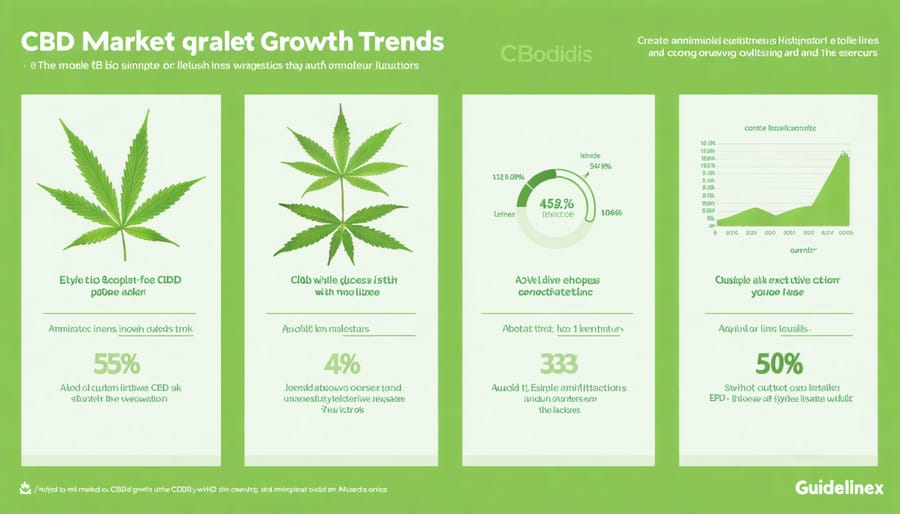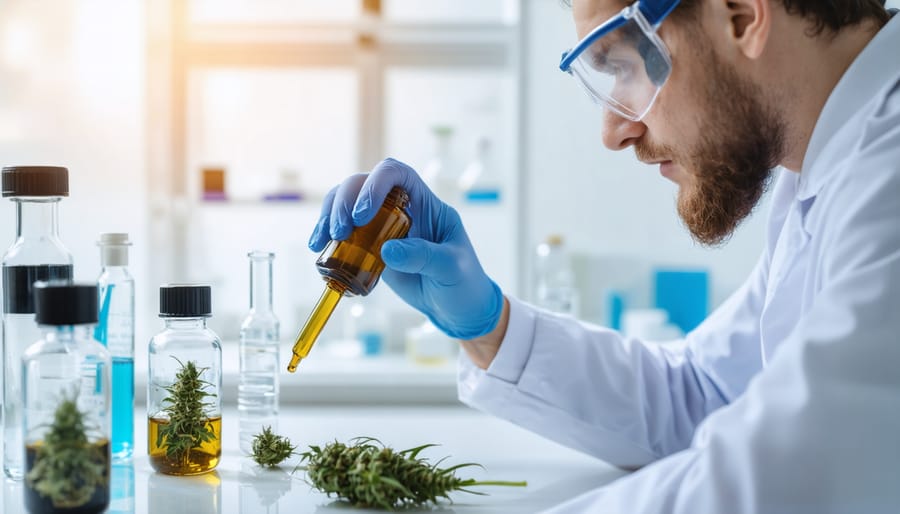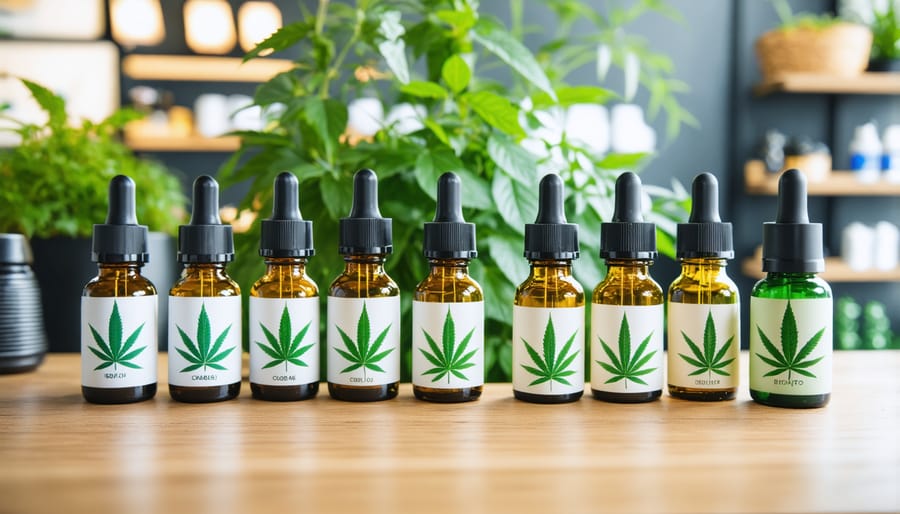The global CBD oil market growth has surged to unprecedented levels, reaching $7.9 billion in 2023 with projections indicating a CAGR of 21.7% through 2030. As wellness-focused consumers embrace alternative remedies alongside traditional offerings like the Dopeboo Mushroom Collection, CBD’s mainstream acceptance continues to reshape the natural products landscape.
This dramatic market expansion stems from three pivotal shifts: increasing legalization across major economies, growing scientific validation of CBD’s therapeutic potential, and sophisticated consumer demand for premium, pharmaceutical-grade products. Major retailers from CVS to Whole Foods have embraced CBD offerings, while pharmaceutical companies invest heavily in research and development, signaling a transformation from niche supplement to mainstream wellness essential.
Innovation in delivery methods, from nanoemulsions to water-soluble formulations, is driving product differentiation and market segmentation. Meanwhile, stringent quality standards and third-party testing requirements are elevating industry credibility, attracting institutional investors and establishing CBD as a legitimate pharmaceutical ingredient rather than merely a cannabis derivative.
Current Market Landscape
Market Size and Valuation
The global CBD oil market has experienced remarkable growth, reaching $7.8 billion in 2022, with projections indicating a substantial expansion to $20.5 billion by 2028. This growth trajectory represents a compound annual growth rate (CAGR) of 17.3%, reflecting the increasing acceptance and understanding of hemp and marijuana differences among consumers.
North America continues to dominate the market, accounting for approximately 40% of global market share, with the United States leading consumption patterns. Canada’s legal framework has created a robust market infrastructure, contributing significantly to regional growth. According to industry analysts at Cannabis Business Times, the Canadian CBD oil market alone is expected to reach $2 billion by 2025.
Market valuation metrics indicate particularly strong growth in wellness and therapeutic segments, with CBD-infused topicals and tinctures showing the highest profit margins. Premium and organic CBD products command higher price points, with average retail margins between 25-35%. European markets are emerging as significant growth drivers, particularly in countries like Germany and the UK, where regulatory frameworks are becoming more accommodating.
Investment in CBD extraction technology and scaling operations has attracted venture capital exceeding $1.3 billion in 2022, highlighting strong investor confidence in the sector’s long-term potential.

Leading Market Players
Several key players dominate the CBD oil market, with companies like Charlotte’s Web Holdings, Canopy Growth Corporation, and Medical Marijuana Inc. leading the way in North America. Charlotte’s Web, based in Colorado, maintains its position as one of the largest vertically integrated CBD companies, known for its high-quality hemp extracts and commitment to sustainable farming practices.
Medical Marijuana Inc. made history as the first publicly traded cannabis company in the United States, while Canopy Growth Corporation has established itself as a major force through strategic acquisitions and partnerships. Aurora Cannabis and CV Sciences have also secured significant market share through innovative product development and extensive distribution networks.
Emerging players like Joy Organics and CBDistillery have gained traction by focusing on organic cultivation and transparent manufacturing processes. European companies like Endoca and Cannabis Sativa, Inc. have expanded their global footprint through e-commerce platforms and international partnerships.
According to industry analysts, these market leaders collectively account for approximately 60% of the global CBD oil market share. Their success can be attributed to robust quality control measures, third-party testing protocols, and strategic marketing initiatives. Many have also invested heavily in research and development, leading to breakthrough formulations and delivery methods that set industry standards.
The competitive landscape continues to evolve as new players enter the market, driving innovation and pushing established companies to maintain their edge through product differentiation and enhanced customer service.
Consumer Behavior Shifts

Demographics and Usage Patterns
Recent market research reveals distinct demographic patterns in CBD oil consumption, with millennials (ages 25-40) representing the largest consumer segment at approximately 41% of users. This group primarily uses CBD oil for anxiety management and sleep improvement, often preferring tinctures and capsules for precise dosing.
Baby boomers (ages 57-75) constitute the fastest-growing demographic, showing a 25% year-over-year increase in CBD oil adoption. This generation typically gravitates toward CBD oil for pain management and inflammation relief, with topical applications being their preferred delivery method.
Usage patterns vary significantly across age groups and regions. Urban consumers tend to incorporate CBD oil into their daily wellness routines, while suburban users show more occasional, targeted usage for specific conditions. Studies indicate that women slightly outpace men in CBD oil consumption, representing 55% of the market, with particular interest in beauty and skincare applications.
Professional athletes and fitness enthusiasts have emerged as a notable consumer segment, primarily using CBD oil for recovery and performance enhancement. This group shows strong brand loyalty and typically opts for premium, high-concentration products.
First-time users generally start with lower concentrations and gradually increase dosage, with 68% reporting continued use after initial trial. Evening consumption dominates usage patterns, with 73% of users applying or ingesting CBD oil products between 6 PM and bedtime.
Purchase Channels
The CBD oil market has witnessed a significant shift in how consumers access these products, with a notable evolution in purchase channels over the past five years. Traditional brick-and-mortar retailers initially dominated the market, but e-commerce has emerged as a powerful force, accounting for approximately 40% of all CBD oil sales in 2023.
Specialized health food stores and wellness centers continue to maintain a strong presence, offering personalized customer service and expert guidance. However, mainstream retailers, including major pharmacy chains and supermarkets, have increasingly added CBD products to their shelves, normalizing CBD oil as a wellness product.
Direct-to-consumer (D2C) channels have gained particular momentum, with many brands developing sophisticated online platforms that offer detailed product information, third-party lab results, and subscription services. This trend accelerated during the COVID-19 pandemic and has maintained its growth trajectory.
Emerging distribution channels include mobile apps, specialized CBD marketplaces, and telehealth platforms that combine product recommendations with virtual consultations. Industry experts note that successful brands are adopting an omnichannel approach, integrating physical retail presence with digital accessibility to meet diverse consumer preferences.
Local dispensaries and cannabis shops represent another significant channel, particularly in regions with established cannabis markets. These specialized retailers often provide extensive product education and maintain strict quality control standards, making them trusted sources for CBD oil purchases.
Product Innovation and Development
Emerging Product Categories
The CBD market is witnessing a surge in innovative product formulations and delivery methods, responding to evolving consumer preferences and technological advancements. Nano-emulsified CBD oils are gaining traction, offering enhanced bioavailability and faster absorption rates compared to traditional formulations. Industry experts report that water-soluble CBD products are particularly appealing to beverage manufacturers and consumers seeking quick-acting effects.
Specialized CBD oil blends incorporating additional beneficial compounds like CBG, CBN, and specific terpene profiles are emerging as premium offerings. These targeted formulations cater to specific wellness goals, from sleep support to focus enhancement. Dr. Sarah Chen, a cannabis researcher, notes that “consumers are becoming more sophisticated in their understanding of cannabinoid profiles and their potential benefits.”
Novel delivery systems including sublingual strips, oral sprays, and precision dosing devices are revolutionizing how consumers use CBD oil. The market is also seeing growth in condition-specific formulations, such as sports recovery blends with cooling agents and skin-penetrating carriers. These innovations reflect a maturing market responding to consumer demand for more effective, convenient, and personalized CBD experiences.

Quality Standards Evolution
The CBD industry has witnessed a significant evolution in quality standards over the past decade, driven by increasing consumer demand for transparency and safety. Third-party laboratory testing has become the gold standard, with leading manufacturers now providing detailed certificates of analysis (COAs) for every batch produced. These tests verify cannabinoid content, terpene profiles, and the absence of contaminants such as pesticides and heavy metals.
Production methods have also advanced considerably, with CO2 extraction emerging as the preferred technique among premium manufacturers. This solvent-free process ensures a cleaner end product while preserving the beneficial compounds of the hemp plant. Industry experts note that implementation of Good Manufacturing Practices (GMP) certification has become increasingly common, particularly among larger producers seeking to differentiate themselves in the market.
Quality control measures now extend beyond production to include seed-to-shelf tracking systems, organic certification programs, and standardized potency testing protocols. According to recent industry surveys, 78% of leading CBD brands have adopted at least one international quality certification, marking a significant shift from the relatively unregulated market of five years ago.
Regulatory Environment Impact
Current Regulatory Framework
The regulatory landscape for CBD oil continues to evolve across major markets, with significant variations between regions. In the United States, the 2018 Farm Bill legalized hemp-derived CBD containing less than 0.3% THC, yet the FDA maintains strict oversight on CBD-infused products in food and beverages. These CBD regulatory challenges have created a complex operating environment for manufacturers and retailers.
In Canada, CBD products fall under the Cannabis Act, requiring strict licensing and quality control measures for production and distribution. The European Union has recently classified CBD as a novel food, implementing specific authorization requirements for CBD-containing products. This classification has standardized regulations across EU member states while creating new compliance requirements for manufacturers.
Asia-Pacific markets present a mixed regulatory picture, with countries like Japan and South Korea allowing CBD products under specific conditions, while others maintain strict prohibitions. Australia has established a comprehensive framework for medicinal CBD, requiring prescription access while maintaining restrictions on over-the-counter sales.
These varying regulatory frameworks significantly impact market access and product development strategies. Industry stakeholders must navigate these complex requirements while adapting to frequent regulatory updates and evolving compliance standards.
Future Regulatory Outlook
The regulatory landscape for CBD oil continues to evolve rapidly, with several significant changes expected in the coming years. Industry experts anticipate that the FDA will establish clearer guidelines for CBD products, particularly regarding labeling requirements and permitted health claims. Dr. Sarah Martinez, a regulatory compliance specialist, suggests that “standardized testing protocols and quality assurance measures will likely become mandatory by 2025.”
Several states are currently drafting legislation to expand CBD product categories, while others are considering stricter oversight of manufacturing processes. The European Union’s novel food regulations are expected to influence North American policy decisions, potentially leading to more stringent product safety requirements and standardized dosage recommendations.
A key development on the horizon is the potential reclassification of certain CBD products, which could allow for broader distribution channels and marketing opportunities. However, this may come with increased compliance costs for manufacturers. Industry analysts project that these regulatory changes could result in a 15-20% increase in operational expenses for CBD companies in the short term.
Interstate commerce regulations are also expected to undergo significant modifications, potentially opening up new markets while simultaneously implementing more rigorous tracking and testing requirements. Companies are advised to prepare for these changes by strengthening their quality control systems and maintaining detailed documentation of their production processes.
The CBD oil market continues to demonstrate remarkable growth and evolution, reflecting broader cannabis industry trends while carving its own distinct path. As we’ve explored throughout this analysis, several key factors are shaping the market’s trajectory. Consumer awareness and acceptance have reached unprecedented levels, driving demand across diverse demographics and applications. The shift toward premium, organic products and innovative delivery methods signals a maturing market that prioritizes quality and effectiveness.
Looking ahead, the CBD oil market is projected to maintain its upward momentum, with analysts forecasting a compound annual growth rate of 21.7% through 2028. This growth will likely be fueled by continued research validating CBD’s therapeutic benefits, expanding legal frameworks, and increasing integration into mainstream wellness products. The emergence of new product categories, particularly in the pharmaceutical and cosmetic sectors, presents significant opportunities for market expansion.
However, challenges remain. Regulatory uncertainties continue to influence market dynamics, while quality control and standardization issues require ongoing attention from industry stakeholders. The competitive landscape is expected to intensify, potentially leading to market consolidation and the emergence of dominant brands focused on product differentiation and scientific validation.
Success in this evolving market will depend on companies’ ability to adapt to changing consumer preferences, maintain compliance with evolving regulations, and invest in research and development. Those who can effectively combine innovation with transparency and quality assurance are likely to capture significant market share. As the industry matures, we can expect to see more sophisticated marketing strategies, improved product formulations, and enhanced customer education initiatives.
The future of the CBD oil market appears promising, but success will require careful navigation of both opportunities and challenges. Stakeholders who remain agile, customer-focused, and committed to quality will be best positioned to thrive in this dynamic marketplace.



